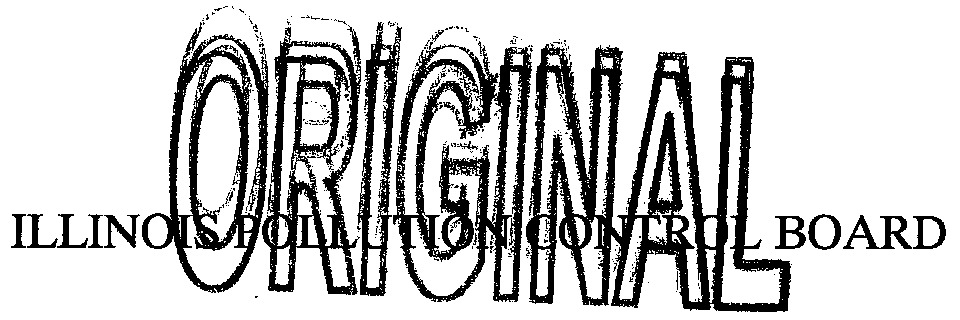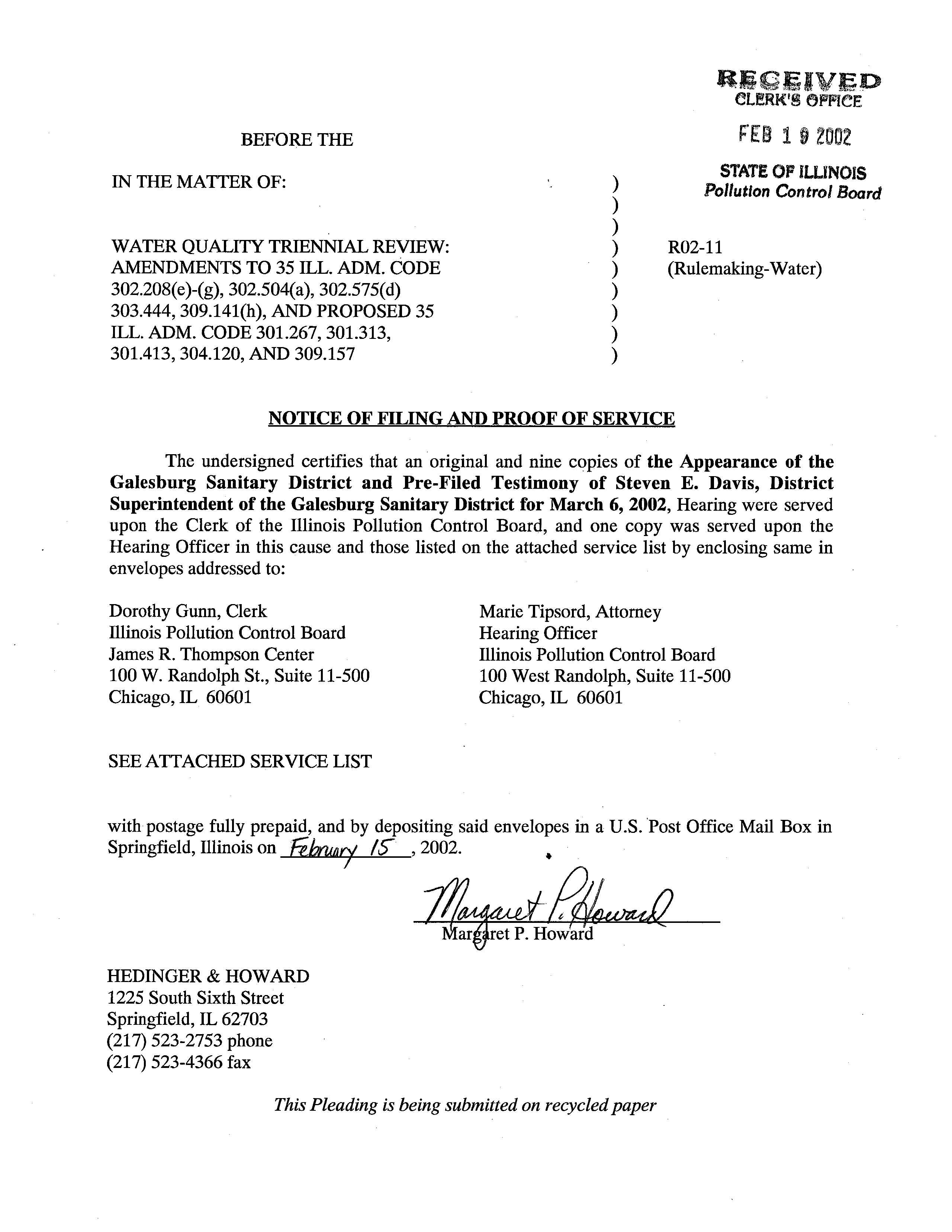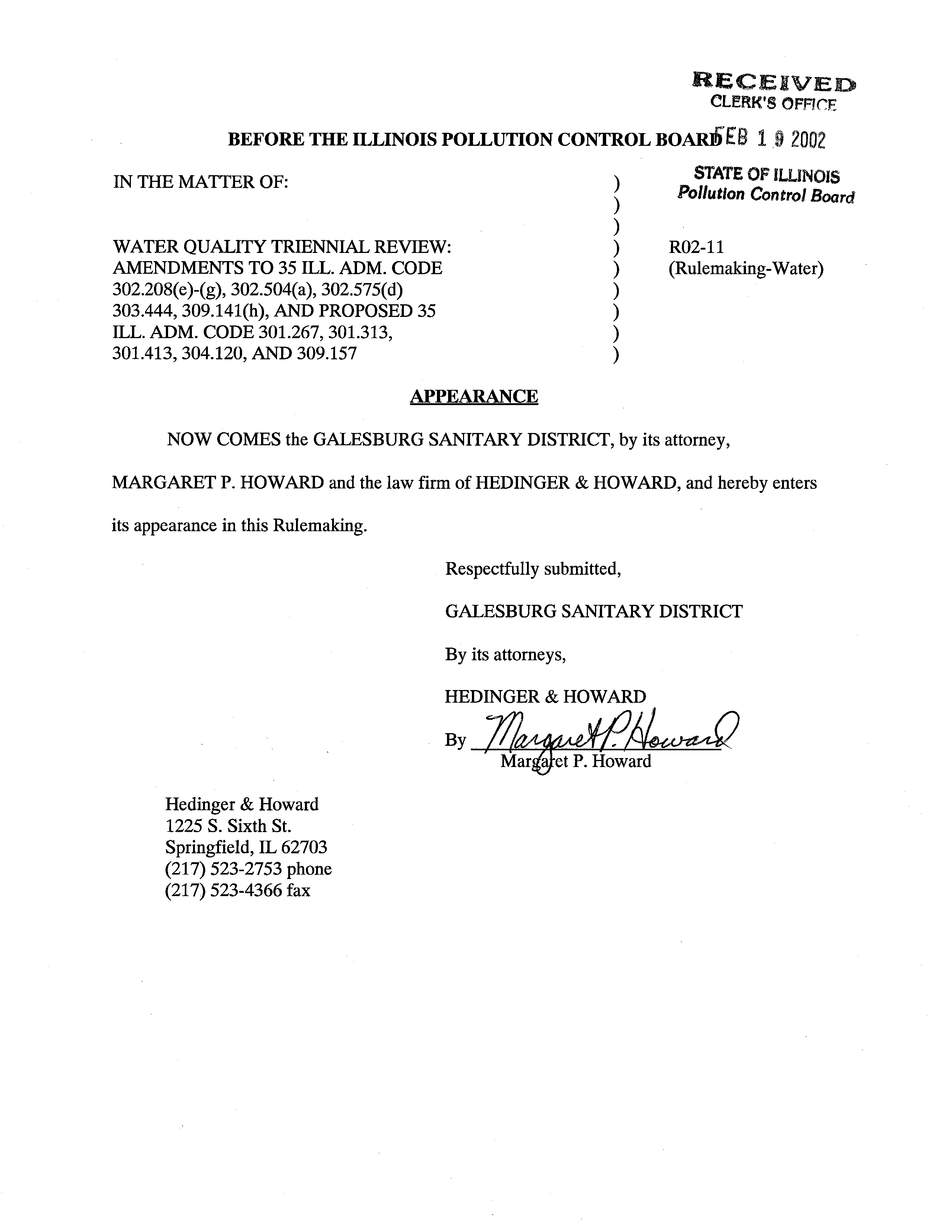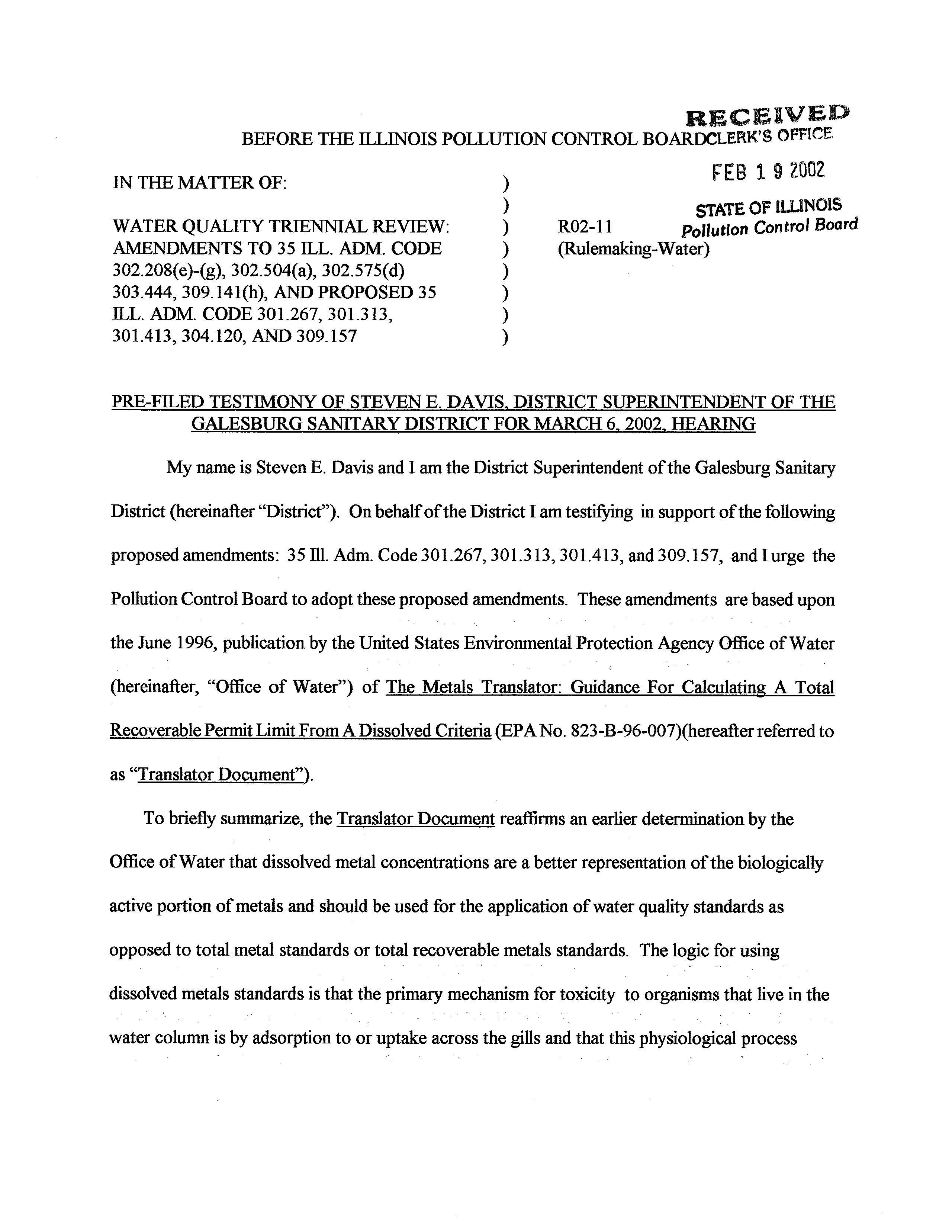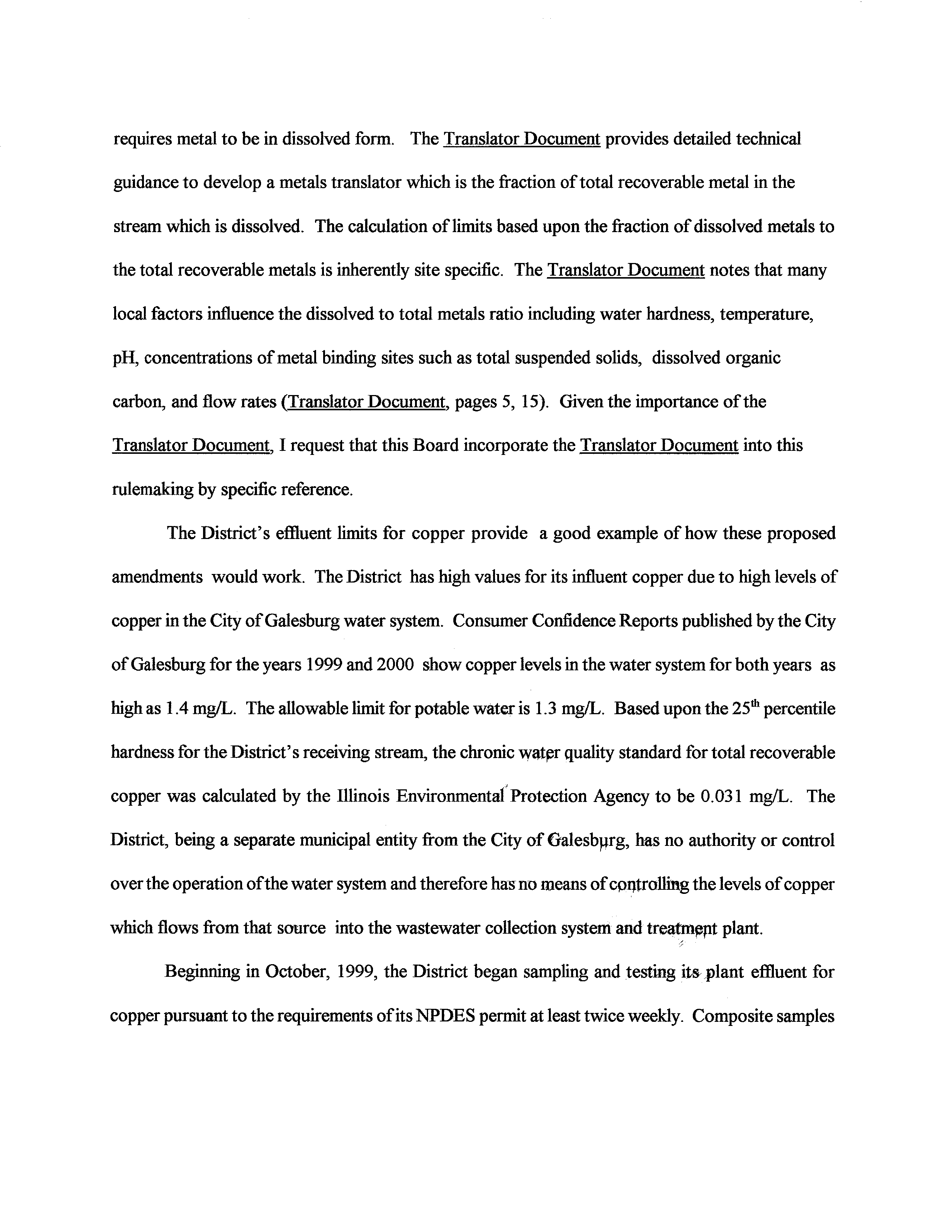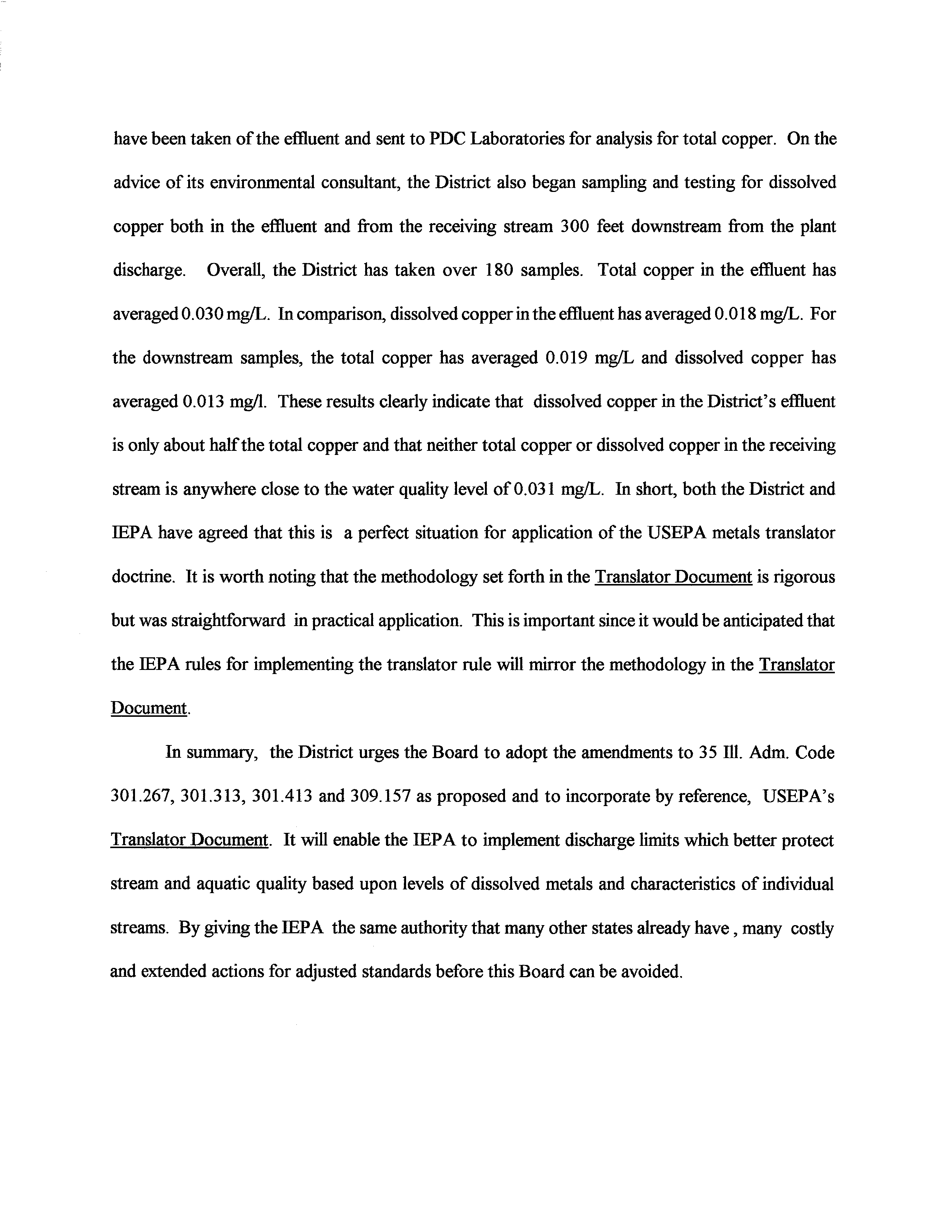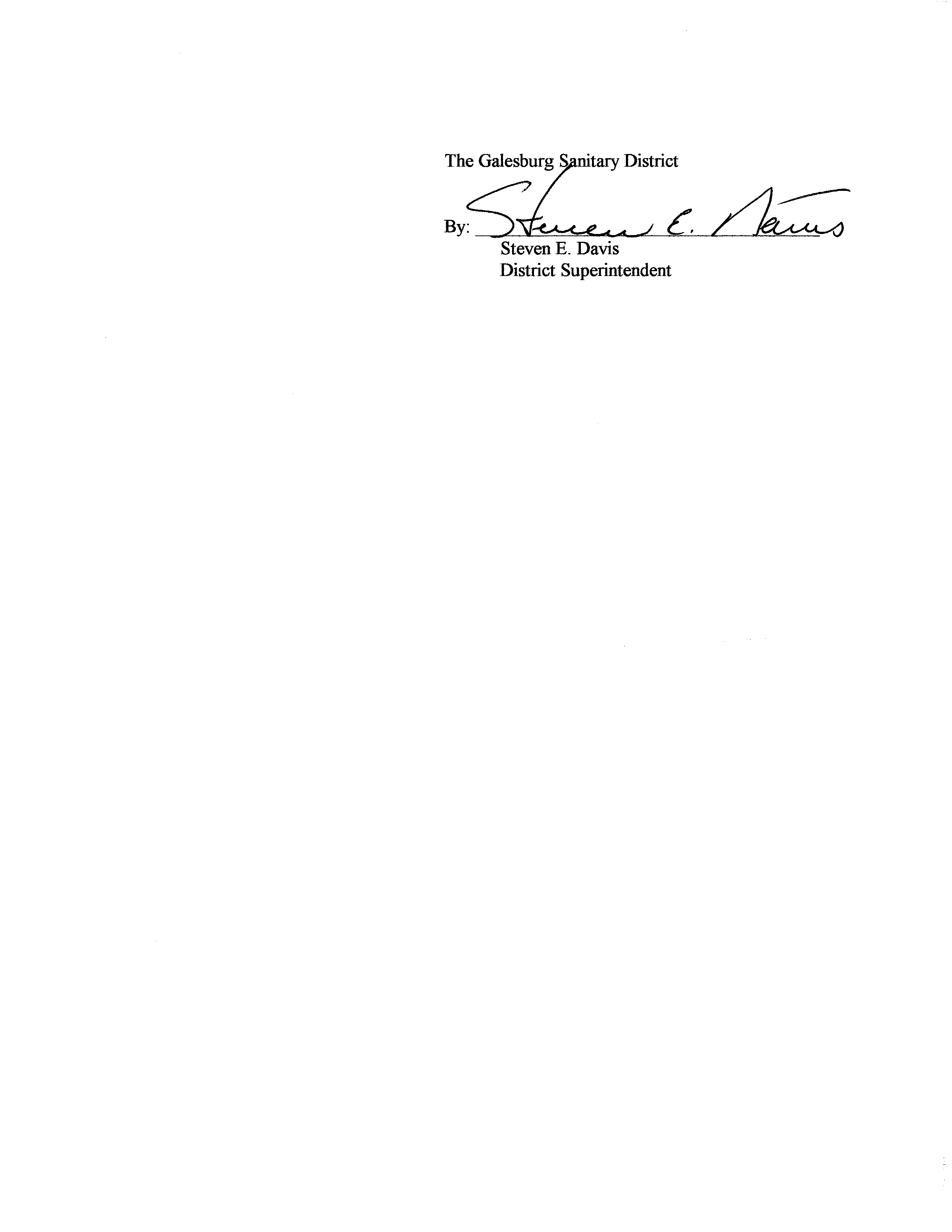Marie Tipsord, Attorney
Hearing Officer
Illinois Pollution Control Board
100 West Randolph, Suite 11-500
Chicago, IL
60601
depositing said envelopes in
a U.S.
Post Office Mail Box in
_____
2002.
)
)
R1~~~V1~
P
CL~!RK~
OPI9CE
FE~
I ~ 2002
STATE OP IWNOIS
Pollution
control Board
R02-11
(Rulemaking-Water)
)
)
)
)
)
)
)
BEFORE THE
IN THE MATTER OF:
WATER QUALITY TRIENNIAL REVIEW:
AMENDMENTS TO
35
ILL. ADM. CODE
302.208(e)-(g),
302.504(a), 302.575(d)
303.444,309.141(h), AND PROPOSED
35
ILL. ADM. CODE 301 .267, 301.313,
301.413, 304.120, AND 309.157
NOTICE OF FILING
AND
PROOF OF SERVICE
The undersigned
certifies that
an
original
and
nine copies of
the Appearance of the
Galesburg
Sanitary
District
and
Pre-Filed
Testimony
of
Steven
E.
Davis,
District
Superintendent of the Galesburg Sanitary District for
March 6,
2002,
Hearing were served
upon
the
Clerk of the
Illinois Pollution
Control Board,
and
one
copy
was
served
upon
the
Hearing Officer in this
cause
and
those listed
on the attached service list by enclosing same in
envelopes addressed to:
Dorothy Gunn, Clerk
Illinois Pollution Control Board
James R. Thompson
Center
100 W. Randolph St., Suite 11-500
Chicago, IL
60601
SEE ATTACHED SERVICE LIST
with
postage fully prepaid, and by
Springfield, Illinois on
_________
_____
HEDINGER & HOWARD
1225 South Sixth Street
Springfield, IL 62703
(217) 523-2753 phone
(217) 523-4366 fax
This Pleading is being submitted on recycledpaper
RECEIVED
CLERK’S
OFFICE
BEFORE THE ILLINOIS POLLUTION CONTROL
BOAR1~EB
1.9
2002
IN THE MATTER OF:
WATER QUALITY TRIENNIAL REVIEW:
AMENDMENTS TO 35 ILL. ADM.
CODE
302.208(e)-(g),
302.504(a), 302.575(d)
303.444, 309.141(h), AND PROPOSED 35
ILL. ADM. CODE 301.267, 301.3 13,
301.413, 304.120, AND 309.157
STATE OF
ILLINOIS
/
Pollution Control Board
)
)
)
)
)
)
)
)
R02-11
(Rulemaking-Water)
APPEARANCE
NOW COMES the GALESBURG SANITARY DISTRICT,
by its attorney,
MARGARET P.
HOWARD
and the law firm of
HEDINGER & HOWARD, and hereby enters
its
appearance in this Rulemaking.
Respectfully submitted,
GALESBURG SANITARY DISTRICT
By its attorneys,
Hedinger & Howard
1225 5. Sixth St.
Springfield, IL 62703
(217) 523-2753 phone
(217) 523-4366 fax
HEDINGER & HOWARD
By
7e~AL~Q
Mar(~etP. Howard
RECEIVED
BEFORE THE ILLINOIS POLLUTION CONTROL BOARDCLERK’S
OFFICE
IN THE MATTER OF:
)
FEB
1
92002
)
STATE OF IWNOIS
WATER QUALITY TRIENNTAL REVIEW:
)
R02l
1
pollutIon
Control
Board
AMENDMENTS TO
35
ILL.
ADM. CODE
)
(Rulemaking-Water)
302.208(e)-(g),
302.504(a), 302.575(d)
)
303.444, 309. 141(h), AND PROPOSED 35
)
ILL. ADM. CODE 301.267,
301.3 13,
)
301.413, 304.120,
AND 309.157
)
PRE-FILED TESTIMONY OF STEVEN E. DAVIS, DISTRICT SUPERINTENDENT OF
THE
GALESBURG SANITARY DISTRICT FOR MARCH 6. 2002. HEARING
My name is StevenE.
Davis and I am the District Superintendent ofthe Galesburg Sanitary
District (hereinafter “District”).
On behalfofthe District I am testif~iingin support ofthefollowing
proposedamendments:
35111. Adm. Code3Ol.267, 301.313, 301.413, and3O9.157,
andlurge
the
Pollution Control Board to adopt these proposed amendments.
These amendments
are based upon
the June 1996, publication by the United States Environmental Protection Agency Office ofWater
(hereinafter,
“Office of Water”) of The
Metals
Translator:
Guidance
For
Calculating
A
Total
Recoverable Permit Limit From ADissolved Criteria(EPANo. 823-B-96-007)(hereafterreferred to
as “Translator Document”).
To briefly summarize, the Translator Document reaffirms an earlier determinationby the
Office ofWater that dissolved metal concentrations are a better representation ofthe biologically
active portion ofmetals and should be used for the application ofwater quality standards as
opposed to total metal standards ortotal recoverable metals standards.
The logic forusing
dissolved metals
standards is that the primary mechanism for toxicity
to organisms that live in the
water column is by adsorption to or uptake across the gills and that this physiological process
requires metal to be in dissolved form.
The Translator Document provides detailed technical
guidance to develop a metals translator which is the fraction oftotal recoverable metal in the
stream which is dissolved.
The calculation oflimits based upon the fraction ofdissolved metals to
the total recoverable metals is inherently site specific.
The Translator Document notes that many
local factors influence the dissolved to total metals ratio including water hardness, temperature,
pH, concentrations ofmetal binding sites
such as total
suspended solids,
dissolved organic
carbon,
and flow rates (Translator Document, pages 5,
15).
Given the importance ofthe
Translator Document, I request that this Board incorporate the Translator Document into this
rulemaking by specific reference.
The District’s effluent
limits for copper provide
a good example of how these proposed
amendments
would work.
TheDistrict
has high values forits influent copper due to high levels of
copper in the City ofGalesburg water system.
Consumer Confidence Reports published by theCity
ofGalesburg for theyears 1999 and 2000
show copperlevels in the water system for both years
as
high as 1.4 mgfL.
The allowablelimit forpotable wateris
1.3 mgfL.
Based upon the
25th
percentile
hardnessfortheDistrict’s receiving stream, the chronicwatpr quality standard for total recoverable
copper was calculated by the Illinois
Environmental~Protection
Agency to be 0.031
mgfL.
The
District,
being a separate municipal entity from the City of(3~a1esbprg,has no authority or control
over the operationofthewater system and therefore hasno means ofcpr~trolling
the levelsofcopper
which flows from that source
into the wastewater collection system and treatm~pt
plant.
Beginning in October,
1999,
the District began
sampling
and testing its plant effluent for
copper pursuant to the requirements ofits NPDES permit at leasttwiceweekly.
Composite samples
have been taken ofthe effluent and sent to PDC Laboratories for analysis fortotal copper.
On the
advice ofits
environmental consultant,
the District also began
sampling and testing for dissolved
copper both
in the effluent
and
from
the receiving stream
300
feet
downstream from the plant
discharge.
Overall, the District
has taken
over
180
samples.
Total copper
in the effluent
has
averaged 0.030 mgfL.
In comparison, dissolved copper in the effluent has averaged 0.018 mgfL. For
the downstream
samples,
the total
copper
has averaged
0.0 19
mgfL
and
dissolved
copper
has
averaged 0.0 13 mg/I.
These results clearly indicate that
dissolved copper in the District’s effluent
is only about halfthe total copper and that neither total copper or dissolved copper in the receiving
stream is anywhere close to the water quality level of 0.031
mg/L.
In short, both the District and
TEPA have agreed that this is
a perfect
situation for application ofthe USEPA metals
translator
doctrine.
It is worth noting that the methodology set forth in the Translator Document is rigorous
but was straightforward in practical application.
This is important since itwould be anticipatedthat
the IEPA rules for implementing the translator rule will mirror the methodology in the Translator
Document.
In summary,
the District urges the Board to adopt the amendments to
35
III. Adm.
Code
301.267,
301.3 13,
301.413
and 309.157
as proposed and to incorporate by reference,
USEPA’s
Translator Document.
It will enable the IEPA to
implement discharge limits which better protect
stream and
aquatic quality
based upon levels of dissolved metals and
characteristics of individual
streams.
By giving the 1EPA the same authority that many other states already have, many
costly
and extended actions for adjusted standards before this Board can be avoided.
The Galesburg S
nitary District
~
Steven E.
Davis
District Superintendent
